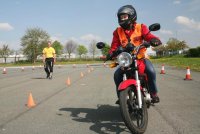
HOW TO PERFORM A PERFECT U-TURN DURING YOUR MOTORCYCLE TEST
Performing a U-turn on your motorcycle test is a nerve-wracking exercise. There are though a few things you can do to make sure you ace it, first time, every time
Perfecting the dreaded feet-up U turn can be one of the most stressful parts of learning to ride a motorbike. Most of us neglect the skill the minute we pass our test, but it can be a useful manoeuvre to have in your back pocket and is much easier than paddling your bike around.
It's also one of the most nerve-wracking parts of your test, despite being one of the slowest speed exercises you will undertake. And that low speed is part of the perceived problem. At low speed, the bike feels vulnerable to wobbles, although there are a few things you can do to ensure you don't fall foul of a fail.
How to perform a perfect U-turn during your motorcycle test
Check for traffic
Whether you are on the test centre or out on the public road, act like there is traffic and make sure you check your blindspot when you pull away and just before you begin to execute the turn. Missing this could result in a fail before you've even hit the road. It's also important not to rush the shoulder check. The examiner will want to see you moving your head in a controlled manner, and looking back for danger even if you both 'know' there isn't any there.
Look where you want to go
This point is drilled into you when you are training, but in truth, it takes quite a while to naturally look when you want to go. To nail the head position, as soon you reach the middle of the road and want to begin heading back in the direction you came, fix your eyes on an imaginary spot about a foot away from the kerb on the opposite side of the road that you started from.
Practise
It makes perfect, dontcha know? Find a quiet road somewhere and practice your U-turns – a few minutes once or twice a week will keep you sharp.
Before you attempt a U-turn, first practice riding slowly in a straight line, and slaloms
Top tips for nailing that motorcycle u-turn
So how is it done? Confidence, which comes from – what else? – practice. But there are a few tricks that help.
Engine revs, clutch
To nail a U-turn on a motorcycle, you need to keep the revs high and clutch instead of the throttle to increase speed. The throttle of most bikes isn't accurate enough to perform a U-turn, for most novice riders anyway, so keep the clutch just past the biting point and try and maintain that position. The examiner doesn't care how fast you rev the engine, in fact, you'll probably get some kudos for using an appropriate amount of revs and nailing the clutch control.
Modern bike
It will almost certainly have a light clutch, a featherweight ride-by-wire throttle and the colossal advantage of centralised mass. Compared with something like my own 1998 Ducati 900SSie (low, narrow bars, leaned-forward riding position, lumpy engine, erratic dry clutch), low-speed manoeuvring is a piece of cake.
Back brake
The third trick is to apply light and continuous pressure to the back brake. This has a similar effect to pulling in the clutch, but because you are dragging the engine down by making the back wheel harder to turn, the whole bike feels planted.
If you need to slow down a little, don't pull the clutch in as you'll disengage drive to the rear wheel and affect the stability of the bike. Instead, to slow down when performing any slow-speed manoeuvre, give a dab of the back brake - but never the front. The rear brake on most bikes (especially those used by motorcycle training centres) is soft and forgiving and will allow you to scrub some speed without affecting the stability of the bike.
Get used to slipping the clutch and balancing it against the rear brake, these definately helps.....
What if your bike is long or awkward to u-turn?
Most bikes should be able to turn in a 20-foot arc, as long as you are confident you can lean the bike properly into the turn. Have your inside foot ready for a ‘dab’ if necessary, but don’t aim to have it on the ground as it will widen the turn. Sitting further forward in the saddle also helps with the steering.
It’s tempting to look at potential hazards like cat’s eyes and the pavement right in front of the bike, but it’s really important that you look where you want to end up heading in the opposite direction.
Don't lean on the steering lock stops
To complete a tight u-turn, you shouldn't actually need all of the steering angle you have on offer. With a little bit of lean, and just the right amount of steering input (plus the points mentioned above), you should easily be able to turn a riding school bike around on a road. Furthermore, leaning on the lock stops generally ends up with the bike toppling inwards, and landing you on the floor with a big fat 'fail' on your test certificate. If you do feel the handlebar hit the steering lock stop, slow the bike down slightly (on the bike brake - don't close the throttle!) and open the steering angle just a fraction.
Article Credits: visordown, motorcyclenews
.png.f357c4bbda45b8d1f0301390a48a7ff4.png)
.thumb.jpg.942d9c8d2090d78b3319f3cc3d3744e6.jpg)












Recommended Comments
There are no comments to display.
Join the conversation
You can post now and register later. If you have an account, sign in now to post with your account.